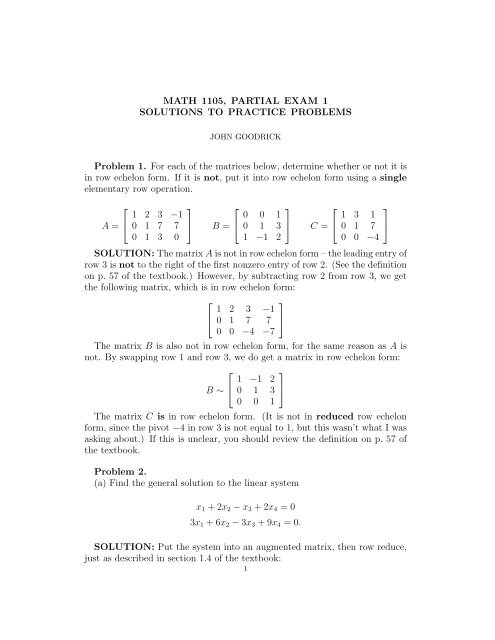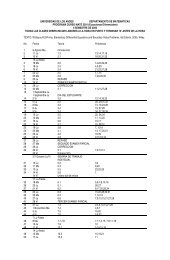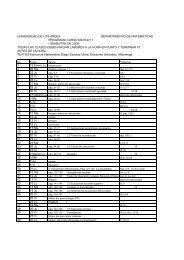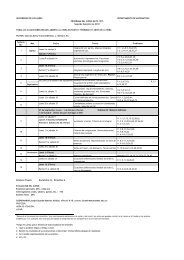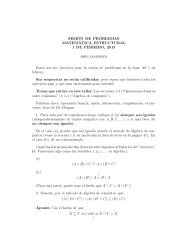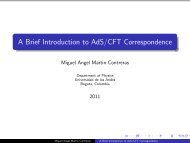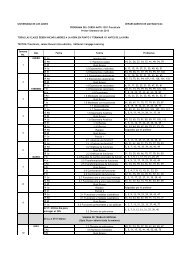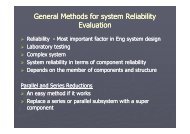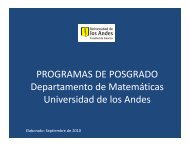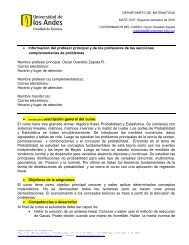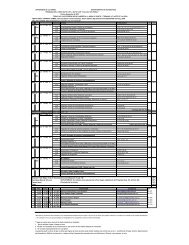MATH 1105, PARTIAL EXAM 1 SOLUTIONS TO PRACTICE ...
MATH 1105, PARTIAL EXAM 1 SOLUTIONS TO PRACTICE ...
MATH 1105, PARTIAL EXAM 1 SOLUTIONS TO PRACTICE ...
- No tags were found...
Create successful ePaper yourself
Turn your PDF publications into a flip-book with our unique Google optimized e-Paper software.
<strong>MATH</strong> <strong>1105</strong>, <strong>PARTIAL</strong> <strong>EXAM</strong> 1<br />
<strong>SOLUTIONS</strong> <strong>TO</strong> <strong>PRACTICE</strong> PROBLEMS<br />
JOHN GOODRICK<br />
Problem 1. For each of the matrices below, determine whether or not it is<br />
in row echelon form. If it is not, put it into row echelon form using a single<br />
elementary row operation.<br />
A =<br />
⎡<br />
⎣ 1 2 3 −1<br />
0 1 7 7<br />
0 1 3 0<br />
⎤<br />
⎦ B =<br />
⎡<br />
⎣ 0 0 1<br />
0 1 3<br />
1 −1 2<br />
⎤<br />
⎦ C =<br />
⎡<br />
⎣ 1 3 1<br />
0 1 7<br />
0 0 −4<br />
SOLUTION: The matrix A is not in row echelon form – the leading entry of<br />
row 3 is not to the right of the first nonzero entry of row 2. (See the definition<br />
on p. 57 of the textbook.) However, by subtracting row 2 from row 3, we get<br />
the following matrix, which is in row echelon form:<br />
⎡<br />
⎣ 1 2 3 −1<br />
0 1 7 7<br />
0 0 −4 −7<br />
The matrix B is also not in row echelon form, for the same reason as A is<br />
not. By swapping row 1 and row 3, we do get a matrix in row echelon form:<br />
B ∼<br />
⎡<br />
⎣ 1 −1 2<br />
0 1 3<br />
0 0 1<br />
The matrix C is in row echelon form. (It is not in reduced row echelon<br />
form, since the pivot −4 in row 3 is not equal to 1, but this wasn’t what I was<br />
asking about.) If this is unclear, you should review the definition on p. 57 of<br />
the textbook.<br />
Problem 2.<br />
(a) Find the general solution to the linear system<br />
⎤<br />
⎦<br />
⎤<br />
⎦<br />
x 1 + 2x 2 − x 3 + 2x 4 = 0<br />
3x 1 + 6x 2 − 3x 3 + 9x 4 = 0.<br />
SOLUTION: Put the system into an augmented matrix, then row reduce,<br />
just as described in section 1.4 of the textbook:<br />
1<br />
⎤<br />
⎦
2 JOHN GOODRICK<br />
[ ] [ ] [ ]<br />
1 2 −1 2 | 0 1 2 −1 2 | 0 1 2 −1 2 | 0<br />
∼<br />
∼<br />
3 6 −3 9 | 0 0 0 0 3 | 0 0 0 0 1 | 0<br />
[ ]<br />
1 2 −1 0 | 0<br />
∼<br />
.<br />
0 0 0 1 | 0<br />
From here, we can read off the general solution: x 1 = −2x 2 + x 3 − 2x 4 ,<br />
x 4 = 0, and since there are no pivots in columns 2 and 3, the variables x 2 and<br />
x 3 are free.<br />
(Don’t forget to say that x 2 and x 3 are free variables!)<br />
(b) Is there any pair of numbers b 1 and b 2 in R such that the system<br />
x 1 + 2x 2 − x 3 + 2x 4 = b 1<br />
3x 1 + 6x 2 − 3x 3 + 9x 4 = b 2<br />
has no solution for x 1 , x 2 , x 3 , and x 4 ? Explain why or why not.<br />
If you write out the augmented matrix for the system with b 1 and b 2 and<br />
row-reduce it like in part (a), you will get:<br />
[ ] [ ]<br />
1 2 −1 2 | b1 1 2 −1 2 | b1<br />
∼<br />
3 6 −3 9 | b 2 0 0 0 3 | b 2 − 3b 1<br />
[ ] [ ]<br />
1 2 −1 2 | b1 1 2 −1 0 | 3b1 − 2b 2<br />
∼<br />
b<br />
0 0 0 1 | 23<br />
∼<br />
3<br />
b<br />
− b 1 0 0 0 1 | 23<br />
.<br />
− b 1<br />
Notice that no matter what the numbers b 1 and b 2 are, the final matrix has<br />
pivots in columns 1 and 4, but no pivot in the rightmost column – therefore<br />
the solution is always consistent, and there is no pair of numbers b 1 and b 2<br />
for which the system has no solution.<br />
Problem 3. (a) Let<br />
⎧⎡<br />
⎨<br />
S = ⎣ 1 2<br />
⎩<br />
3<br />
⎤<br />
⎦ ,<br />
⎡<br />
⎣ 4 5<br />
6<br />
⎤<br />
⎦ ,<br />
⎡<br />
⎣ 7 8<br />
9<br />
⎤⎫<br />
⎬<br />
⎦<br />
⎭ .<br />
Is S linearly independent? Explain why or why not.<br />
SOLUTION: The best general way to do a problem like this is to put the<br />
vectors into a matrix A (as columns), then row-reduce:<br />
⎡<br />
A = ⎣ 1 4 7<br />
⎤ ⎡<br />
2 5 8 ⎦ ∼ ⎣ 1 4 7<br />
⎤ ⎡<br />
0 −3 −6 ⎦ ∼ ⎣ 1 4 7<br />
⎤<br />
0 −3 −6 ⎦ .<br />
3 6 9 0 −6 −12 0 0 0<br />
This last matrix is in row echelon form, but there is no pivot in the third<br />
column – therefore S is linearly dependent.
<strong>MATH</strong> <strong>1105</strong>, <strong>PARTIAL</strong> <strong>EXAM</strong> 1 <strong>SOLUTIONS</strong> <strong>TO</strong> <strong>PRACTICE</strong> PROBLEMS 3<br />
(b) Is S a basis for R 3 ?<br />
SOLUTION: No, S is not a basis for R 3 . Any basis must be linearly<br />
independent (see Theorem 2.1 in the textbook), and by part (a), S is not<br />
linearly independent.<br />
(c) Find a basis for span(S).<br />
SOLUTION: To find the basis, we put the vectors into a matrix A as<br />
columns and row reduce to row echelon form, as in part (a). Since there are<br />
pivots in columns 1 and 2 (but not in column 3), a basis for the span of S is<br />
the first two vectors in S:<br />
⎧⎡<br />
⎤ ⎡ ⎤⎫<br />
⎨<br />
⎣ 1 2 ⎦ ,<br />
⎩<br />
3<br />
⎣ 4 5<br />
6<br />
⎬<br />
⎦<br />
⎭ .<br />
Problem 4. For each of the following matrices, determine whether or not<br />
it is invertible. If it is invertible, find its inverse.<br />
⎡<br />
[ ]<br />
2 1<br />
A =<br />
B = ⎣ 1 0 1<br />
⎤<br />
[ ]<br />
0 1 0 ⎦ 1 0 1<br />
C =<br />
1 2<br />
0 1 0<br />
1 0 1<br />
Solution:<br />
D =<br />
⎡<br />
⎢<br />
⎣<br />
0 1 0 0<br />
1 0 0 0<br />
2 0 1 0<br />
2<br />
3 0 0 −1<br />
⎤<br />
⎥<br />
⎦ .<br />
The matrix A is invertible:<br />
[ ] [ ] [<br />
2 1 | 1 0 2 1 | 1 0 1<br />
1 1<br />
| 0<br />
∼<br />
1 2 | 0 1 0 3 | − 1 ∼ 2 2<br />
1 0 3 | − 1 1<br />
2 2 2 2<br />
[ ] [ ]<br />
1<br />
1 1<br />
| 0<br />
∼ 2 2 1 0 |<br />
2<br />
−<br />
0 1 | − 1 2 ∼<br />
1 3 3<br />
0 1 | − 1 2 .<br />
3 3<br />
3 3<br />
]<br />
The matrix B is not invertible. We can see this is by counting its pivots:<br />
by subtracting Row 1 from Row 3, we get the reduced row echelon matrix<br />
⎡<br />
⎣ 1 0 1<br />
⎤<br />
0 1 0 ⎦ ,<br />
0 0 0
4 JOHN GOODRICK<br />
which has pivots in only 2 of the 3 columns, and so B cannot be row reduced<br />
to I 3 . Therefore B is not invertible.<br />
The matrix C is not invertible, simply because it is not a square matrix.<br />
Recall that in the definition of an invertible matrix (on page 75 of the textbook),<br />
we require that the matrix be n × n for some n.<br />
For the matrix D, we augment the matrix by I 4 on the right and then rowreduce<br />
the left half (as in section 1.5):<br />
∼<br />
⎡<br />
⎢<br />
⎣<br />
⎡<br />
⎢<br />
⎣<br />
0 1 0 0 | 1 0 0 0<br />
1 0 0 0 | 0 1 0 0<br />
2 0 1 0 | 0 0 1 0<br />
2<br />
3 0 0 −1 | 0 0 0 1<br />
1 0 0 0 | 0 1 0 0<br />
0 1 0 0 | 1 0 0 0<br />
0 0 1 0 | 0 −2 1 0<br />
2<br />
0 0 0 −1 | 0 −3 0 1<br />
⎤<br />
⎡<br />
⎥<br />
⎦ ∼ ⎢<br />
⎣<br />
⎤ ⎡<br />
⎥<br />
⎦ ∼ ⎢<br />
⎣<br />
1 0 0 0 | 0 1 0 0<br />
0 1 0 0 | 1 0 0 0<br />
2 0 1 0 | 0 0 1 0<br />
2<br />
3 0 0 −1 | 0 0 0 1<br />
⎤<br />
⎥<br />
⎦<br />
1 0 0 0 | 0 1 0 0<br />
0 1 0 0 | 1 0 0 0<br />
0 0 1 0 | 0 −4 2 0<br />
0 0 0 1 | 0 3 0 −1<br />
Since we were able to row-reduce the left half to the identity matrix I 4 , the<br />
matrix D is invertible, and the row reduction above shows that<br />
⎡<br />
⎤<br />
0 1 0 0<br />
D −1 = ⎢ 1 0 0 0<br />
⎥<br />
⎣ 0 −4 2 0 ⎦ .<br />
0 3 0 −1<br />
Problem 5. (a) Write the solution set of<br />
3x 1 + 2x 2 + 7x 3 + x 4 = 2<br />
3x 1 + 3x 2 + 6x 3 + x 4 = 17<br />
as ⃗p + span(⃗v 1 , ⃗v 2 ) for some vectors ⃗p, ⃗v 1 , and ⃗v 2 .<br />
SOLUTION: First, you should find the general solution by the method in<br />
section 1.4:<br />
[<br />
3 2 7 1 | 2<br />
3 3 6 1 | 17<br />
⎤<br />
⎥<br />
⎦ .<br />
] [ ] [ ]<br />
3 2 7 1 | 2 1<br />
2 7 1 2<br />
|<br />
∼<br />
∼ 3 3 3 3<br />
0 1 −1 0 | 15 0 1 −1 0 | 15<br />
[ ]<br />
1 0 3<br />
1<br />
| −<br />
∼<br />
28 3 3 .<br />
0 1 −1 0 | 15<br />
This is in reduced row echelon form, so we can read of the general soution:<br />
x 1 = −3x 3 − 1 3 x 4 − 28 3 , x 2 = x 3 + 15, and x 3 and x 4 are free.<br />
From here, we can proceed as in section 1.6: the solution set consists of all<br />
(x 1 , x 2 , x 3 , x 4 ) in R 4 such that
<strong>MATH</strong> <strong>1105</strong>, <strong>PARTIAL</strong> <strong>EXAM</strong> 1 <strong>SOLUTIONS</strong> <strong>TO</strong> <strong>PRACTICE</strong> PROBLEMS 5<br />
⎡ ⎤ ⎡<br />
x 1<br />
⎢ x 2<br />
⎥<br />
⎣ x 3<br />
⎦ = ⎢<br />
⎣<br />
x 4<br />
−3x 3 − 1 3 x 4 − 28 3<br />
x 3 + 15<br />
x 3<br />
x 4<br />
⎤<br />
⎥<br />
⎦ = x 3<br />
⎡<br />
⎢<br />
⎣<br />
−3<br />
1<br />
1<br />
0<br />
⎤<br />
⎥<br />
⎦ + x 4<br />
⎡<br />
⎢<br />
⎣<br />
− 1 3<br />
0<br />
0<br />
1<br />
⎤ ⎡<br />
⎥<br />
⎦ + ⎢<br />
⎣<br />
Therefore we can let ⃗p = [ − 28 3 , 15, 0, 0] , ⃗v 1 = [−3, 1, 1, 0], and ⃗v 2 = [ − 1 3 , 0, 0, 1] .<br />
(This is not the only possible solution to this problem.)<br />
(b) Write the solution set of<br />
as the span of two vectors.<br />
3x 1 + 2x 2 + 7x 3 + x 4 = 0<br />
3x 1 + 3x 2 + 6x 3 + x 4 = 0<br />
SOLUTION: Note that this homogeneous linear system is the same as the<br />
system in part (a) except that the numbers on the right sides of the equations<br />
are 0. So using the same row reduction as in part (a), we get:<br />
[<br />
3 2 7 1 | 0<br />
3 3 6 1 | 0<br />
]<br />
∼<br />
[<br />
1 0 3<br />
1<br />
3<br />
| 0<br />
0 1 −1 0 | 0<br />
Now using the same technique as in part (a), we can see that the general<br />
solution is<br />
⎡ ⎤ ⎡<br />
x 1 −3x 3 − 1 ⎢ x 2<br />
⎥<br />
⎣ x 3<br />
⎦ = x ⎤ ⎡<br />
3 4<br />
⎢ x 3<br />
⎥<br />
⎣ x 3<br />
⎦ = x ⎢<br />
3 ⎣<br />
x 4 x 4<br />
with x 3 and x 4 free. So the solution set is<br />
⎛⎡<br />
⎤ ⎡<br />
−3 − 1 3<br />
span ⎜⎢<br />
1<br />
⎥<br />
⎝⎣<br />
1 ⎦ , ⎢ 0<br />
⎣ 0<br />
0 1<br />
−3<br />
1<br />
1<br />
0<br />
⎤<br />
⎥<br />
⎦ + x 4<br />
⎤⎞<br />
⎥⎟<br />
⎦⎠ .<br />
Problem 6. Let S be the set of all vectors ⃗v in R 3 such that<br />
⃗v · [1, 3, 11] = 0.<br />
Is S a subspace of R 3 ? Why or why not?<br />
SOLUTION: Yes, the set S is a subspace of R 3 . One way to see this is to<br />
note that S is the set of all ⃗v = [v 1 , v 2 , v 3 ] such that<br />
v 1 + 3v 2 + 11v 3 = 0,<br />
⎡<br />
⎢<br />
⎣<br />
]<br />
.<br />
− 1 3<br />
0<br />
0<br />
1<br />
⎤<br />
⎥<br />
⎦ ,<br />
− 28 3<br />
15<br />
0<br />
0<br />
⎤<br />
⎥<br />
⎦ .
6 JOHN GOODRICK<br />
which is a homogeneous linear system (with only one equation), and as explained<br />
in section 1.6, the solution set to a homogeneous linear system is always<br />
a subspace of the appropriate R n .<br />
Alternatively, you could have checked that the zero vector [0, 0, 0] is in S<br />
and that S is closed under vector addition and scalar multiplication – see<br />
Definition 1.16 on page 89 of the textbook.<br />
Problem 7. For how many different vectors ⃗v in R 3 is it true that<br />
⎧⎡<br />
⎨<br />
Span ⎣ 1 ⎤ ⎡<br />
0 ⎦ , ⎣ 0 ⎤ ⎫<br />
⎬<br />
1 ⎦ , ⃗v<br />
⎩<br />
0 0<br />
⎭ = R3 ?<br />
Explain.<br />
SOLUTION: There are infinitely many such vectors ⃗v.<br />
Here one way to prove this: if we write<br />
⎡<br />
⃗v = ⎣ v ⎤<br />
1<br />
v 2<br />
⎦ ,<br />
v 3<br />
then by Theorem 1.16 of section 1.6, the span of the set<br />
⎧⎡<br />
⎨<br />
⎣ 1 ⎤ ⎡<br />
0 ⎦ , ⎣ 0 ⎤ ⎫<br />
⎬<br />
1 ⎦ , ⃗v<br />
⎩<br />
0 0<br />
⎭<br />
is all of R 3 if and only if the matrix<br />
⎡<br />
A =<br />
⎣ 1 0 v ⎤<br />
1<br />
0 1 v 2<br />
⎦<br />
0 0 v 3<br />
is row equivalent to I 3 .<br />
The matrix A is already in row echelon form. It has either two or three<br />
pivots, depending on whether or not v 3 = 0: the two 1’s are pivots in any case,<br />
the v 3 in the lower right is a pivot if it is nonzero, and otherwise v 3 is not a<br />
pivot. As long as v 3 ≠ 0, we can row reduce the matrix A to I 3 by adding<br />
appropriate multiples of row 3 to rows 1 and 2. (The values of v 1 and v 2 do<br />
not matter.)<br />
Since there are infinitely many such choices for v 3 (it can be any nonzero<br />
number in R), there are infinitely many such vectors ⃗v.<br />
Problem 8. Is the vector (0, 3, 1) in<br />
⎧⎡<br />
⎨<br />
Span ⎣ 1 ⎤ ⎡<br />
2 ⎦ , ⎣ 2 ⎤⎫<br />
⎬<br />
1 ⎦<br />
⎩<br />
1 1<br />
⎭ ?<br />
Explain why or why not.
<strong>MATH</strong> <strong>1105</strong>, <strong>PARTIAL</strong> <strong>EXAM</strong> 1 <strong>SOLUTIONS</strong> <strong>TO</strong> <strong>PRACTICE</strong> PROBLEMS 7<br />
SOLUTION: Yes, the vector (0, 3, 1) is in this span.<br />
The vector (0, 3, 1) is in this span if and only if the system<br />
⎡ ⎤ ⎡ ⎤ ⎡ ⎤<br />
x 1 ·<br />
⎣ 1 2<br />
1<br />
⎦ + x 2 ·<br />
⎣ 2 1<br />
1<br />
⎦ =<br />
⎣ 0 3<br />
1<br />
has a solution for x 1 and x 2 . But this is equivalent to the linear system<br />
x 1 + 2x 2 = 0<br />
2x 1 + x 2 = 3<br />
x 1 + x 2 = 1.<br />
We convert this into an augmented matrix, then row reduce:<br />
⎡<br />
⎣ 1 2 | 0<br />
2 1 | 3<br />
1 1 | 1<br />
⎤<br />
⎦ ∼<br />
⎡<br />
⎣ 1 2 | 0<br />
0 −3 | 3<br />
0 −1 | 1<br />
⎤<br />
⎦ ∼<br />
⎡<br />
⎦<br />
⎣ 1 2 | 0<br />
0 −3 | 3<br />
0 0 | 0<br />
This last matrix is in row echelon form, with pivots in columns 1 and 2, but<br />
no pivot in the rightmost column. Therefore the system is consistent (it has a<br />
solution).<br />
⎤<br />
⎦ .


